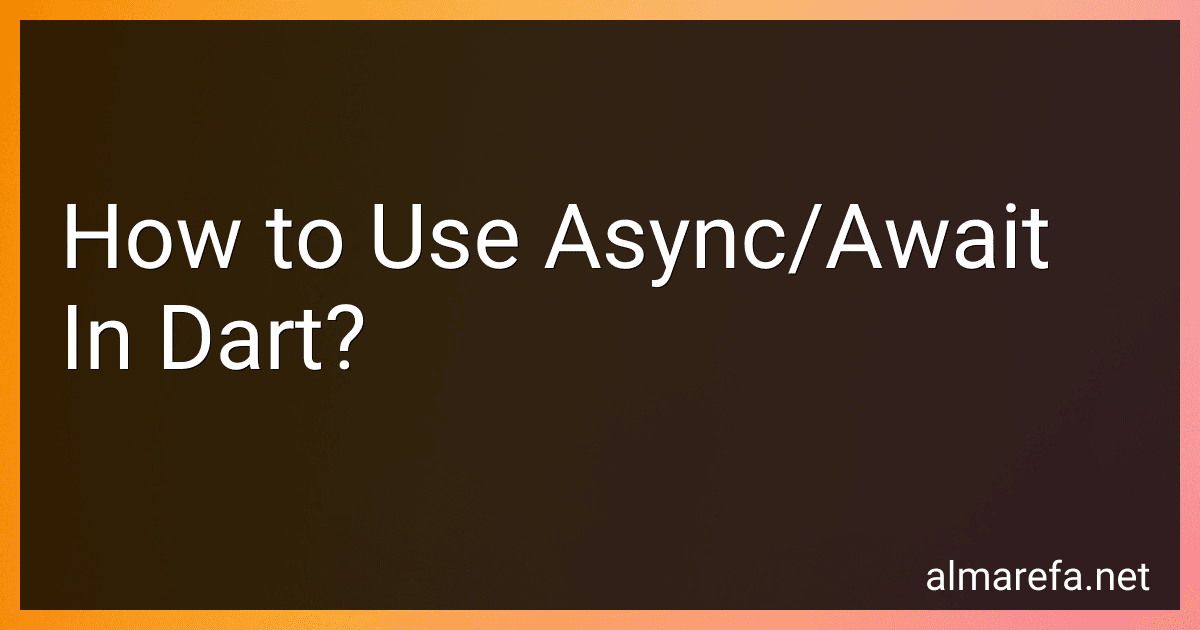Posts (page 53)
-
 7 min readWorking with streams in Dart allows for efficient and asynchronous handling of data. Streams are essentially sequences of data elements that can be processed individually as they become available, without waiting for the entire data to be loaded.To work with streams in Dart, you can follow these steps:Create a stream: Use the Stream class to create a stream of data. Streams can be either single-subscription or broadcast.
7 min readWorking with streams in Dart allows for efficient and asynchronous handling of data. Streams are essentially sequences of data elements that can be processed individually as they become available, without waiting for the entire data to be loaded.To work with streams in Dart, you can follow these steps:Create a stream: Use the Stream class to create a stream of data. Streams can be either single-subscription or broadcast.
-
 8 min readAsync/await is a powerful feature in Dart that allows you to write asynchronous code in a more concise and readable manner. It is commonly used when performing time-consuming operations such as making API calls or accessing databases.To use async/await in Dart, you need to understand a few key concepts:Async Functions: An async function is defined using the async keyword before the function body's return type.
8 min readAsync/await is a powerful feature in Dart that allows you to write asynchronous code in a more concise and readable manner. It is commonly used when performing time-consuming operations such as making API calls or accessing databases.To use async/await in Dart, you need to understand a few key concepts:Async Functions: An async function is defined using the async keyword before the function body's return type.
-
 5 min readIn Dart, asynchronous code can be written using the Future class, which allows you to represent a potential value or error that may be available at some point in the future. Here is an explanation of how to write asynchronous code using Future in Dart.To create an asynchronous function that returns a Future, you can prefix the function declaration with the async keyword. Within the function body, you can use the await keyword to pause the execution of the function until a Future completes.
5 min readIn Dart, asynchronous code can be written using the Future class, which allows you to represent a potential value or error that may be available at some point in the future. Here is an explanation of how to write asynchronous code using Future in Dart.To create an asynchronous function that returns a Future, you can prefix the function declaration with the async keyword. Within the function body, you can use the await keyword to pause the execution of the function until a Future completes.
-
 4 min readTo read user input in Dart, you can use the standard input/output methods provided by the dart:io library. Here's how you can do it:Import the dart:io library: import 'dart:io'; Create an instance of the stdin object from the io library: var input = stdin; Read input from the user using the readLineSync() method: var userInput = input.readLineSync(); Use the user input as desired: print('You entered: $userInput'); That's it.
4 min readTo read user input in Dart, you can use the standard input/output methods provided by the dart:io library. Here's how you can do it:Import the dart:io library: import 'dart:io'; Create an instance of the stdin object from the io library: var input = stdin; Read input from the user using the readLineSync() method: var userInput = input.readLineSync(); Use the user input as desired: print('You entered: $userInput'); That's it.
-
 12 min readJoomla, an open-source content management system, can be deployed on various web hosting platforms that meet its system requirements. Here are some common options for deploying Joomla:Shared Hosting: Many web hosting companies offer shared hosting plans where multiple websites share the resources of a single server. Shared hosting is an affordable option for small to medium-sized websites. Virtual Private Server (VPS): A VPS provides greater control and resources compared to shared hosting.
12 min readJoomla, an open-source content management system, can be deployed on various web hosting platforms that meet its system requirements. Here are some common options for deploying Joomla:Shared Hosting: Many web hosting companies offer shared hosting plans where multiple websites share the resources of a single server. Shared hosting is an affordable option for small to medium-sized websites. Virtual Private Server (VPS): A VPS provides greater control and resources compared to shared hosting.
-
 5 min readString manipulation in Dart involves various operations to manipulate the contents of a string. Here are some common techniques:Concatenation: You can concatenate multiple strings using the '+' operator. For example: String str1 = "Hello"; String str2 = "World"; String result = str1 + " " + str2; // "Hello World" Length: To get the length of a string, you can use the length property. For example: String str = "Hello"; int stringLength = str.
5 min readString manipulation in Dart involves various operations to manipulate the contents of a string. Here are some common techniques:Concatenation: You can concatenate multiple strings using the '+' operator. For example: String str1 = "Hello"; String str2 = "World"; String result = str1 + " " + str2; // "Hello World" Length: To get the length of a string, you can use the length property. For example: String str = "Hello"; int stringLength = str.
-
 4 min readWorking with collections in Dart, such as lists, maps, and sets, allows you to efficiently manage and manipulate groups of related data. These data structures provide different ways to store, access, and modify data.Lists: A list in Dart represents an ordered collection of objects. It is similar to an array in other programming languages. You can create a list using the List class. Lists can contain objects of any type, and they can be mutable (modifiable) or immutable (read-only).
4 min readWorking with collections in Dart, such as lists, maps, and sets, allows you to efficiently manage and manipulate groups of related data. These data structures provide different ways to store, access, and modify data.Lists: A list in Dart represents an ordered collection of objects. It is similar to an array in other programming languages. You can create a list using the List class. Lists can contain objects of any type, and they can be mutable (modifiable) or immutable (read-only).
-
 7 min readMixins in Dart provide a way to reuse code across multiple class hierarchies. They are similar to interfaces in other languages, but with the ability to provide a default implementation.To use mixins in Dart, you need to define a mixin using the mixin keyword. For example: mixin Logger { void log(String message) { print('[LOG] $message'); } } You can then use the mixin in a class by using the with keyword.
7 min readMixins in Dart provide a way to reuse code across multiple class hierarchies. They are similar to interfaces in other languages, but with the ability to provide a default implementation.To use mixins in Dart, you need to define a mixin using the mixin keyword. For example: mixin Logger { void log(String message) { print('[LOG] $message'); } } You can then use the mixin in a class by using the with keyword.
-
 12 min readNode.js can be deployed on various platforms and environments, offering flexibility for developers to choose the best option based on their project requirements. Some common places to deploy Node.js applications include:Cloud Platforms: Popular cloud platforms like Amazon Web Services (AWS), Google Cloud Platform (GCP), and Microsoft Azure provide infrastructure as a service (IaaS) or platform as a service (PaaS) offerings where you can easily deploy Node.js applications.
12 min readNode.js can be deployed on various platforms and environments, offering flexibility for developers to choose the best option based on their project requirements. Some common places to deploy Node.js applications include:Cloud Platforms: Popular cloud platforms like Amazon Web Services (AWS), Google Cloud Platform (GCP), and Microsoft Azure provide infrastructure as a service (IaaS) or platform as a service (PaaS) offerings where you can easily deploy Node.js applications.
-
 4 min readTo instantiate an object in Dart, you can use the new keyword followed by the class name and parentheses. Here's an example: // Define a class class Person { String name; int age; // Constructor Person(this.name, this.age); void introduceYourself() { print("Hello, my name is $name and I am $age years old."); } } void main() { // Instantiate an object of the Person class var person = new Person("John", 25); // Access object properties print(person.
4 min readTo instantiate an object in Dart, you can use the new keyword followed by the class name and parentheses. Here's an example: // Define a class class Person { String name; int age; // Constructor Person(this.name, this.age); void introduceYourself() { print("Hello, my name is $name and I am $age years old."); } } void main() { // Instantiate an object of the Person class var person = new Person("John", 25); // Access object properties print(person.
-
 10 min readVue.js can be deployed in various environments, allowing developers to create and deploy robust web applications. Here are some popular deployment options for Vue.js:Static Websites: Vue.js can be used to build static websites using tools like Vue CLI. Once developed, the static files can be hosted on a basic web server environment. Content Management Systems (CMS): Vue.js can be integrated into CMS platforms such as WordPress or Drupal by creating custom themes or plugins.
10 min readVue.js can be deployed in various environments, allowing developers to create and deploy robust web applications. Here are some popular deployment options for Vue.js:Static Websites: Vue.js can be used to build static websites using tools like Vue CLI. Once developed, the static files can be hosted on a basic web server environment. Content Management Systems (CMS): Vue.js can be integrated into CMS platforms such as WordPress or Drupal by creating custom themes or plugins.
-
 4 min readTo create a class in Dart, you can use the class keyword followed by the name of the class. Here's an example of a basic class: class Person { // Properties String name; int age; // Constructor Person(this.name, this.age); // Methods void speak() { print("Hello, my name is $name and I am $age years old."); } } Let's break down the components of this class:The Person class is declared using the class keyword followed by the class name.
4 min readTo create a class in Dart, you can use the class keyword followed by the name of the class. Here's an example of a basic class: class Person { // Properties String name; int age; // Constructor Person(this.name, this.age); // Methods void speak() { print("Hello, my name is $name and I am $age years old."); } } Let's break down the components of this class:The Person class is declared using the class keyword followed by the class name.